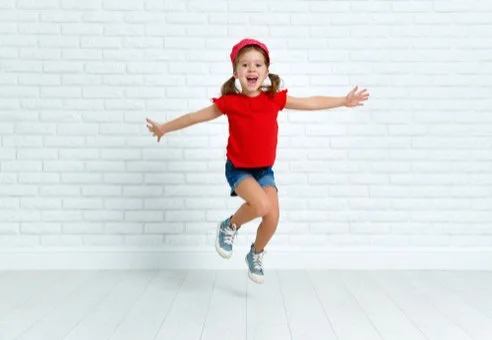Teaching Your Child To Jump
Learning to jump is an exciting and fun milestone in your child’s life! Learning to jump will help your child to keep up and participate with their friends in sports and other physical play, which gives them lifelong opportunities for fitness and socialising. As a result, jumping is an important milestone that we often work on with the children we see at Move and Play.
Most typically developing children learn to jump by around 3 years of age. However, each child is different, so some children will learn to jump before 3, and some children will learn to jump after 3. Children with motor difficulties or disabilities may learn to jump many years after this.
Jumping requires strong legs, a strong trunk, coordination and balance. Regardless of the age your child is learning to jump, here are some tips and strategies to help your child to learn to jump well so that they are bounding around in no time.
Rocket jumps or frog jumps: Show or help your child to squat down low into a deep squat. From this position you can count down (’10, 9, 8, 7, 6, 5, 4, 3, 2, 1, Blast Off!’) or get them to jump up like a frog. Bending down in a deep squat position and then rising back to standing helps to strengthen their leg muscles which will help them to learn to jump. You can also encourage them to stand up really quickly which helps them to learn to propel themselves upwards quickly with their legs.
Rising up on toes: The other leg muscles that are important for jumping is the calf muscles. Having strong calf muscles will help your child to propel themselves upwards and off the ground. You can help your child to build their calf strength by getting them to rise up on their toes. By encouraging them to do this quickly, you are also helping them to develop the propulsion they need to get up off the ground.
Jumping on a kids mini tramp with a grip bar: These mini tramps are great to help your child work on the action of jumping without having to also balance because they have the bar to hold onto. Unlike when they try to jump off the ground, using the mini tramp also gives your child momentum to help them to get clearance off the mini tramp. This helps them to develop their coordination and strength in preparation for being able to jump off the ground.
Jumping in the pool: Practicing jumping in the pool means that your child’s body weight is supported by the water, which will help them to be able to jump without having to push up against their whole body weight. This is a great way to help your child to experience clearance off the ground. Being in the water also helps to slow your child’s movements down, which will help their balance when learning this new skill. Quick tip: The deeper the water, the more your child will be supported; the shallower the water, the less your child will be supported – so make sure you progress from deeper water to shallower water.
Jumping with hands held: This will help your child to practice the action and experience getting off the ground, even if they haven’t yet got the strength to do so.
Jumping off a low step/curb/obstacle etc: Unlike jumping off the ground, jumping off a low step or curb does not require as much clearance of the feet from the ground. So if your child has trouble with their upward momentum, you could try jumping forwards first off something low first until they get the hang of coordinating their legs to jump together in an upwards direction.
Once your child has mastered a basic two legged jump, you can then progress to teaching them to jump over obstacles, hopping, jumping with a skipping rope, and many other fun activities.
If you are concerned that your child is not progressing towards learning to jump, a therapist who works specifically with children may be able to give them the helping hand they need to master this milestone. Move and Play’s therapists frequently help children to learn this important skill.
Contact our clinic today by email or phone on (07) 4942 9343 to find out how our physiotherapist and occupational therapists can help your child.

